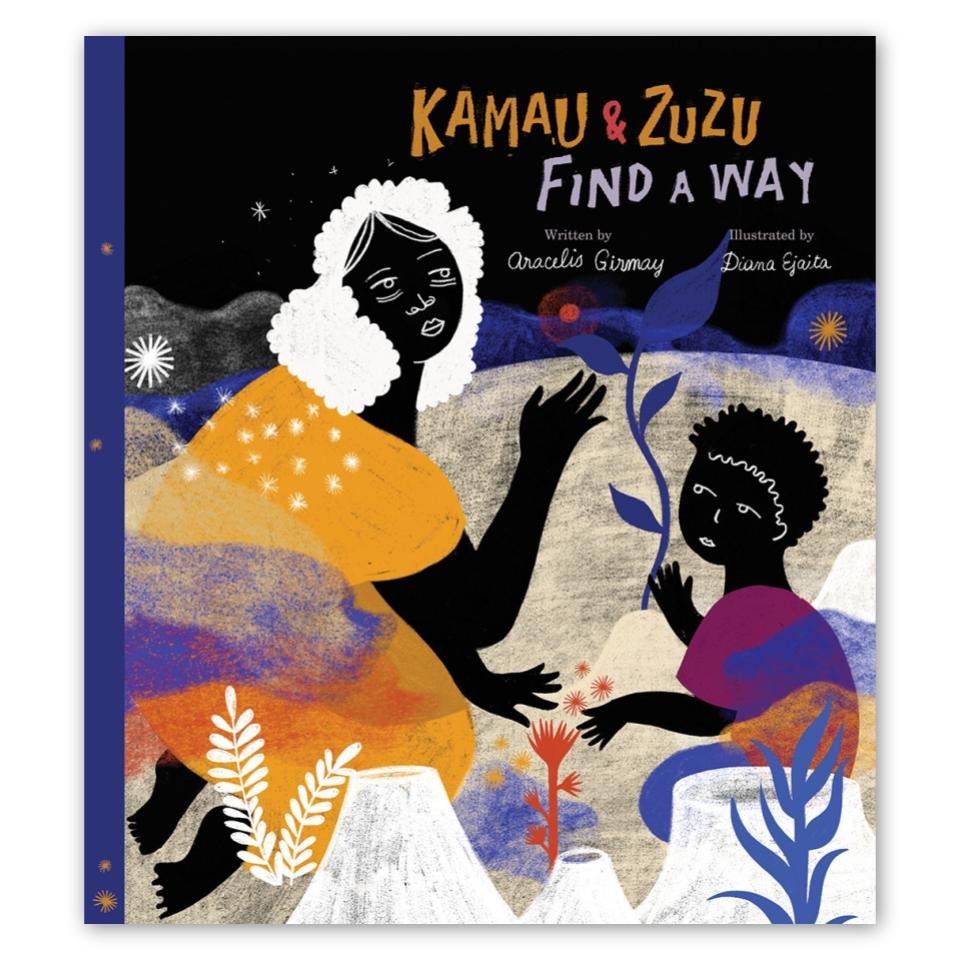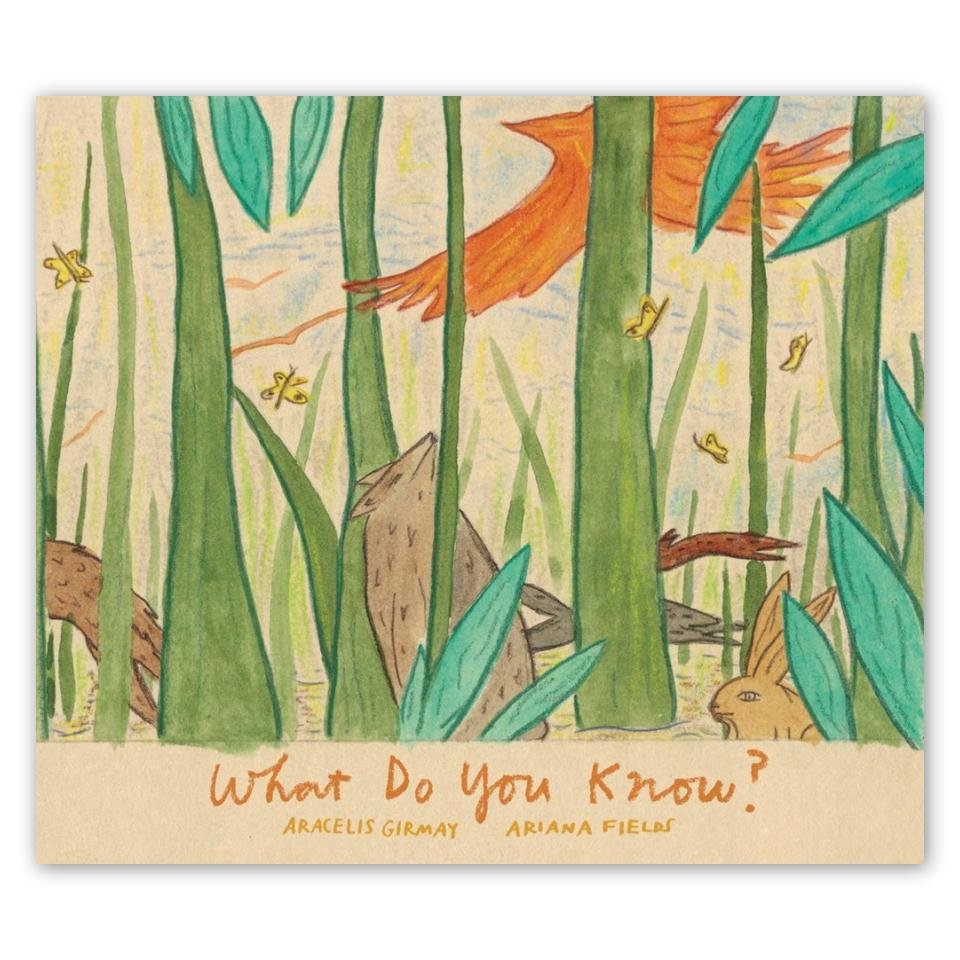"How do we create beauty in unfamiliar places? How do we carry our histories forward?" A student exhibit at the Intersect Arts Center inspired by KAMAU & ZUZU FIND A WAY
Written by renowned poet Aracelis Girmay and illustrated by artist Diana Ejaita, Kamau & ZuZu Find a Way is a stirring story of African diaspora, resourcefulness, and intergenerational love. This spring, the students and teachers of the Intersect Arts Center in St. Louis read the picture book together and created art to bring its story to life, transforming the center’s gallery space into “a multimedia wonderland of story, color, poetry, and place-making.”
Our most heartfelt thanks to director of arts education Aida Hasanovic, the Artventures after-school program staff, and the brilliant students who created the art you’ll see below. We hope you enjoy this virtual visit!
To learn more about the Intersect Arts Center and to support their mission, please visit: www.intersectstl.org.
This spring, our students read Kamau & ZuZu Find a Way and explored its powerful themes of memory, resilience, and imagination. Through painting, sculpture, storytelling, and movement, they engaged deeply with the book’s intimate questions: How do we create beauty in unfamiliar places? How do we carry our histories forward?
What you see in this exhibit is the result: an ode to the stubborn courage it takes to make a lush life out of even the most arid circumstances, and to the defiant will to prevail over the odds with fearless grace.
THE MOON: FROM A PLACE OF EXILE TO A PLACE OF NEW POSSIBILITY
Kamau & ZuZu Find a Way, written by acclaimed poet Aracelis Girmay and illustrated by Diana Ejaita, tells the story of a young boy, Kamau, and his grandmother, ZuZu. One day, they wake up and find themselves on the Moon—far from their family, their home, and everything familiar.
Kamau doesn’t remember Back Home, but ZuZu does. She remembers the village, the smells of home cooking, the songs, the sea, and the warmth of family. The Moon feels cold, quiet, and deeply unfamiliar—but together, Kamau and ZuZu begin to plant a life there. It is a story about longing, memory, and what it means to make a home when the one you knew has been lost or taken from you.
This powerful story uses the Moon as a symbol of separation—of what it feels like to be taken from your homeland, your family, or your culture. The story’s themes speak to anyone who has ever felt displaced, uprooted, or far from home.
At its heart, Kamau & ZuZu Find a Way is a story about resilience and imagination—about how we survive loss and separation by holding fast to memory, tradition, and love. ZuZu’s strength lies not in escaping sorrow, but in transforming it. As she looks out at their life on the Moon, knowing it is not the home she would have chosen for her grandson, she says: “But we will have to find a way to live, as people do.” “Something about the way she said ‘live,’” the narrator tells us, “always filled Kamau’s blood up with sun.”
THE GARDEN: ROOTED IN NEW SOIL
In Kamau and ZuZu Find a Way, the garden blooms with moon corn, an imagined crop born of memory, hope, and survival. It stands as a symbol for what people of the African Diaspora have always done: plant what they have, nurture it with care, and grow life from displacement.
When enslaved Africans were forced across the Atlantic, they carried seeds braided into their hair: okra, black-eyed peas, rice—ancestral crops now deeply rooted in American soil. These acts of preservation were more than survival; they were declarations of identity.
The garden reminds us of the essential role of Black farmers, land stewards, and growers in shaping agricultural landscapes in both Africa and the Americas. Like ZuZu, we grow with what we have, sowing heritage into every furrow, and finding resilience in the act of cultivation.
The Belt of Seeds
When imagining clothing and accessories for the book Kamau and Zuzu Find A Way, Gabby imagined this belt.
The denim reflects the indigo dyeing practice seen in West Africa. Referencing the seeds in ZuZu's pockets, Gabby used denim pockets to construct the belt and placed flowers in them.
To Gabby, these represented the seeds blooming from the pockets and creating a beautiful garden.
“And from the
photograph of
ZuZu's mother
grew a large quilt
of stars to keep
them warm.”
“And from the square of cloth, a wide and silent kite.”
ZUZU’S TEARS: THE WATER REMEMBERS
ZuZu’s tears become the sea where messages are carried, a sacred space in the African Diaspora. A witness to pain, a bearer of spirit, a bridge between worlds. This exhibit holds the weight of the Middle Passage, where millions were taken from their homelands and cast into an unknown future.
Yet in these waters also lives remembrance. Across the Black Atlantic, water rituals, libations, and prayers link us to the ancestors who walked into the sea or crossed it in chains. ZuZu’s tears are a call to the spirits, an echo of longing, loss, and connection.
This space asks us to listen. To feel. To honor. Here, water becomes a conduit for ancestral wisdom, a mirror of our collective grief, and a wellspring of spiritual power. The sea took, but it also holds. And in its depths, we find a sacred tether to where we come from and to who we’ve never stopped being.
ST. LOUIS: OUR VILLAGE HOME
St. Louis holds the layered histories, traditions, and memories, just like ZuZu carries with her on the moon. St. Louis is full of people who hold onto culture, who create beauty from what’s around them, and who keep stories alive through art, movement, and music. Even in the face of hardship or change, there’s a deep sense of rootedness in the city—a kind of generational resilience and love that holds communities together.
This collection of student artwork is rooted in the layered histories, everyday beauty, and enduring spirit of St. Louis. Inspired by the work of artist Leroy Johnson—who used found materials to honor Black life, history, and resilience—we explored what it means to create from what’s been discarded, forgotten, or overlooked. Like Johnson, we used found objects, textures, and mixed media to tell stories of our city: the blocks we live on, the people we love, the things that make us feel seen, and the parts of the city that often go unnoticed. Each piece is both a memory and a vision—a way to hold space for struggle, joy, change, and survival.
St. Louis has a long history shaped by segregation, displacement, resistance, and brilliance. This work adds their voices to the city's story.
THE UTOPIA: SANKOFA DREAMS
Utopia in this gallery is not perfection, it is possibility. This space holds the tension between loss and legacy, remembering and becoming. Here, the African Diaspora steps into its full reflection: who we were before the rupture of enslavement, and who we are now, reassembling ourselves through memory and motion.
Sankofa, which means “go back and fetch it,” teaches us to look back in order to move forward, to reclaim the pieces left behind so we can build something whole. This exhibit celebrates the innovations, beauty, and survival that define our present. It honors the artists, activists, teachers, and visionaries who carry ancestral dreams into new futures. We are no longer only what was done to us; we are what we do with it. This is a tribute to becoming and to being our ancestors’ wildest dreams.
“WE FOUND A WAY
THROUGH STORIES,
THROUGH ROOTS,
THROUGH RHYTHM AND TRUTH.
I AM KAMAU.
HEART FULL OF DRUMBEATS.
EYES WIDE WITH THE MEMORY OF ANCESTORS—
THEY WHISPERED THROUGH THE WIND,
’CHILD, REMEMBER WHO YOU ARE.’ AND I DO.
IN EVERY STEP, I CARRY AFRICA IN MY STRIDE.
I AM ZUZU.
MY BRAIDS HOLD HISTORY.
MY LAUGHTER CARRIES LAGOS AND LOUISIANA, I SPEAK IN SONGS MY GRANDMA HUMMED WHILE STIRRING POTS OF OKRA AND HOPE.
I AM THE DAUGHTER OF STORYTELLERS,
A BRIDGE ACROSS THE SEA.
WE WALK DIFFERENT STREETS, BUT THE RHYTHM FINDS US—
IN THE BOOM-BAP OF THE BRONX, THE BOUNCE OF KINGSTON, THE SWAY OF CAPE TOWN, AND THE STILLNESS OF SANKOFA.
WE ARE MANY PLACES.
ONE PEOPLE.
NOT LOST—
JUST WOVEN INTO EVERY CONTINENT,
EVERY BEAT OF THE DJEMBE, EVERY VERSE OF RESISTANCE.
BLACK IS NOT BROKEN.
BLACK IS BUILDING.
WE RISE LIKE SUGARCANE FROM CRACKED EARTH,
STRETCHING TOWARD SUN, UNBREAKABLE, UNASHAMED.
WE CARRY JOY IN OUR POCKETS, SPILLED FROM THE MOUTHS OF GRIOTS.
PAINTED IN COLORS THAT SPEAK LOUDER THAN WORDS.
WE REMEMBER—
EVEN WHEN THE WORLD FORGETS.
DIASPORA MEANS WE MADE IT. MADE SOMETHING BEAUTIFUL.
OUT OF STORMS.
OUT OF STRUGGLE.
OUT OF SOUL.
WE ARE KAMAU.
WE ARE ZUZU.
WE ARE THE ECHO AND THE FLAME.
FROM DRUM TO PAGE, FROM PAST TO PRESENT—
WE FOUND A WAY.”
KAMAU & ZUZU FIND A WAY
★ STARRED REVIEW! "Examining the challenges of being forced to leave one’s home, this visually gorgeous, nuanced work echoes stories from the African diaspora as well as global areas of conflict. Girmay’s folkloric text is simple and straightforward yet deeply moving... A stunning and empathetic look at the struggles of displacement." —Kirkus Reviews
★ STARRED REVIEW! “Through its gorgeous and evocative artwork, this book conveys emotions of loss, resilience, and hope… The theme of finding one’s place in the world makes it an ideal resource for teaching about resilience, self-discovery, and SEL. It delicately and poetically addresses some of the most challenging realities students may face, [which] makes it a powerful tool for building empathy and understanding among a wide range of students… VERDICT: A highly recommended addition to any library, offering visual beauty and a meaningful narrative that will resonate with young readers and educators alike.” —School Library Journal
★ STARRED REVIEW! “Girmay’s contemporary folktale uses succinct, direct language to convey the anguish of relocation and celebrate the resilience necessary to survive in a new land. Striking... Compelling and heartfelt.” —Booklist
“So incredible… Truly beautiful… This book is a jaw-dropper.” —Betsy Bird, A Fuse 8 Production (a School Library Journal blog)
A Marginalian Favorite of 2024! “Captures the essence of the human spirit… Lifeblood for the soul from cover to cover.” —Maria Popova, The Marginalian
ALSO BY ARACELIS GIRMAY: WHAT DO YOU KNOW?
“Author Aracelis Girmay and illustrator Ariana Fields, who are sisters, have created a sweeping, complex and mysterious vision of love in the picture book What Do You Know? … Dreamlike… Fosters a sense of the wondrous width of the world and the connections between seemingly disparate things in it.” —Wall Street Journal
“Employing incantatory lines that conjure flame-like warmth and reverence, Girmay and Fields acknowledge the kind of knowing that’s older than books.” —Publishers Weekly
“A contemplative, enigmatic exploration of life on planet Earth.” —Kirkus Reviews
“Simple and profound like a child’s question… What emerges is a glowing sense that love is not something we do but something we are, something the world is, something vaster than space and older than time.” —Maria Popova, The Marginalian
“Created by two sisters, this picture book… celebrates the wild diversity of life on earth but also the connection to wonder and mystery around us. The book is simple yet deeply profound, offering hope in darkness, the breath of whales and bears, and the magnificence of change even if it takes millennia… Gorgeous, deep and full of marvels.” —Waking Brain Cells

































